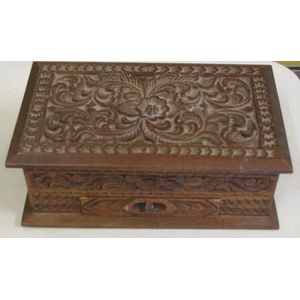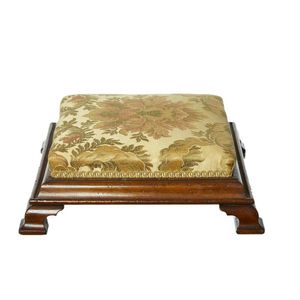Georgian Mahogany Footstool with Carved Frame and Cushion
You must be a subscriber, and be logged in to view price and dealer details.
Subscribe Now to view actual auction price for this item
When you subscribe, you have the option of setting the currency in which to display prices to $Au, $US, $NZ or Stg.
- Mahogany - Mahogany is a dense, close grained red-coloured timber from the West Indies and Central America. It was first imported into Europe in the the early 18th century and its use continued through the 19th century. It was popular for furniture making because of its strength, the wide boards available, the distinctive grain on some boards, termed flame mahogany and the rich warm colour of the timber when it was polished.. The "flame" was produced where a limb grew out from the trunk of the tree, and this timber was usually sliced into veneers for feature panels on doors, backs and cornices.
Some terms used to describe mahogany relate to the country from which it originally came, such as "Cuban" mahogany, "Honduras" mahogany etc. However unless the wood has been tested the names assigned are more a selling feature, rather than a true indication of the timber's origin. - George Iii - George III (1738 - 1820) was King of Great Britain and Ireland from 1760 to 1820.
- Circa - A Latin term meaning 'about', often used in the antique trade to give an approximate date for the piece, usually considered to be five years on either side of the circa year. Thus, circa 1900 means the piece was made about 1900, probably between 1895 and 1905. The expression is sometimes abbreviated to c.1900.
- Bracket Feet - On bracket feet the corner edge is square and joined by a mitre to its partner on the opposite angle. The inner edge is usually shaped or scalloped. Bracket feet were first introduced in the early 18th century and used until c. 1830 and are found on carcase furniture such as chests, cabinets, bookcases and bureaux.
Ogee bracket feet, a variation on straight bracket feet, have the outside edge forming an "S" shaped curve with the top bulging outward and the bottom turning inward.
On splayed bracket feet, the exterior edge curves outward. - Ogee - A serpentine shape, usually convex at the upper part, concave at the lower. Mostly used to describe the front shapes of parts of carcass furniture, such as cornices, drawer fronts and feet.
This item has been included into following indexes:
- stools, period or age - Georgian 89
-
stools, type or function
- foot stools 180
- upholstered 338
Visually similar items

A Chinese carved hardwood mother of Peal inlay screen early 20th century decorated with carved relief depicting exotic birds, figures and auspicious animals, height 87 cm, width 59 cm

Chinese carved timber jewelry box, 33 cm wide. Opens up to mirror backed lid . Circa 1970

A Tibetan gilt copper repousse on wood book cover, 16th century, depicting three enthroned buddhas attended by their guards with the eight auspicious symbols, turquoise and coral inlay, 61 cm width x 21.5 cm height. Provenance: Private collection, Canberra

Chinese huanghuali cabriole leg Kang table (Kangzhuo) of waisted form, the apron carved with birds and flowers among rockeries, top with attractive grain and patina, measures 66 cm wide, 43 cm deep, 24 cm high
